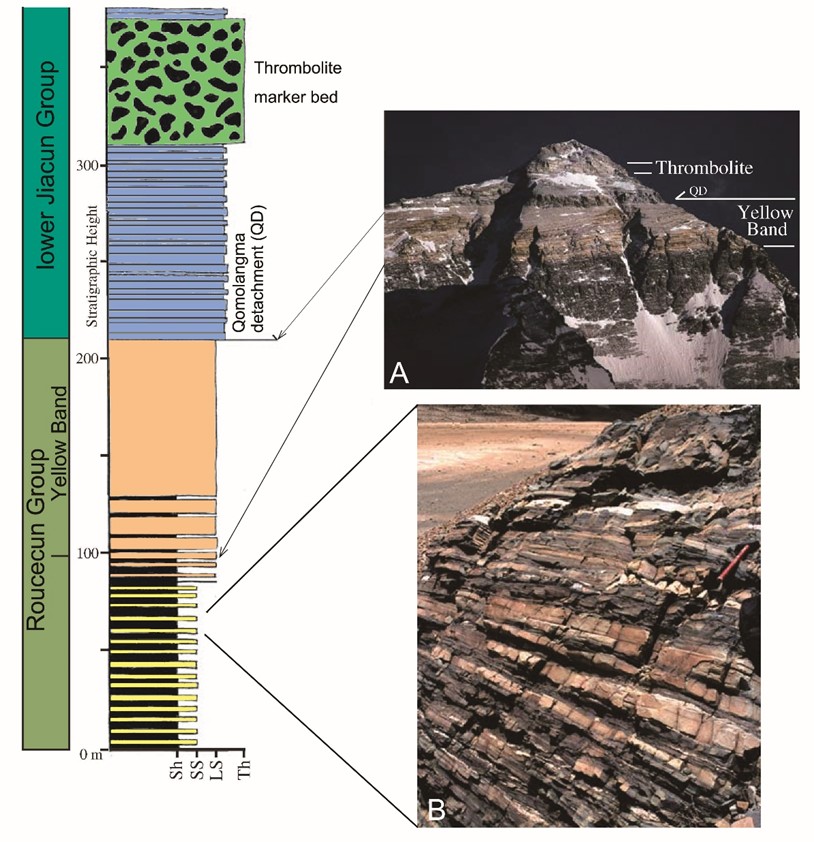Rouqiecun Gr
Type Locality and Naming
The type section of the Rouqiecun Group is located on the west bank of Boqu River in the Rouqiecun Village, about 30 km north of the seat of Nyalam County, Xigazê, Tibet (86°07’E, 28°22’N). It was measure by Mu et al. (1973). The Rouqiecun Group was firstly published by Mu et al. (1973). The name is derived from Rouqiecun Village, Nyalam County, Xigazê Prefecture, Tibetan Autonomous Region. The name was originally appeared in a 1959 manuscript by Yang Jingzhi, Qian Yiyuan and colleagues from Nanjing Institute of Geology and Palaeontology, Chinese Academy of Sciences.
Synonym: (肉切村群); Mu et al. (1973) divided the Rouqiecun Group into two rock formations. The upper formation comprises yellow crystalline limestone or dolomite (“Yellow Band”), and the lower formation consists of back, striped diopside quartzose schist. Tibet Regional Geological Survey Team (1983) excluded the “Yellow Band” from the Rouqiecun Group and referred it to the base of Jiacun Fm and restricted the group to the lower formation. This restricted group concept has been accepted by the Tibet Bureau of Geology (1993), and Xia and Liu (1997); but is not followed in this Lexicon. The Yellow Band is considered to be the upper part of the Rouqiecun Group based on the correction to other yellow bands of the Himalayan Region (Myrow et al., 2009, 2016). It may represent the youngest formation of the group.
Lithology and Thickness
The Rouqiecun Group is mainly a sequence of metamorphic rocks, with a crystalline limestone bed, Yellow Band, at the top. The group consists of greyish black, striped diopside quartzose schist, intercalated with dolomite, shale, fine-grained mica-rich schist, a kind of skarn-type contact-metamorphic rock, and contains injected white migmatic veins. In the type section at Nyalam, the group is about 110 m thick.
[Figure 1: Stratigraphic section of Rouqiecun Gr (Cambrian) and lower Jiacun Fm (Ordovician) from Nyalam, Tibet. Lithologies along x-axis of measured section: Sh—shale, SS—sandstone, LS—limestone/dolomite, Th—thrombolite. A, Photograph of Mount Qomolangma (Everest) showing position of the Yellow Band, Qomolangma detachment (QD), and thrombolite unit; the thinner lines indicate relative positions of the top and base of the Yellow Band to the those at the Nyalam section. B, Close-up of stratigraphic equivalent of the Rouqiecun Group in Nyalam, Tibet, showing well-preserved bedding and stratification in middle Cambrian strata. Hammer in upper right is 35 cm long. (Modified from Myrow et al., 2009, 2016)]
[Figure 2: A, Outcrop of the orange-weathering dolostone bed from the Rouqiecun Gr in Nyalam. Hammer for scale. B, Close-up of dolostone bed at Nyalam showing sheared internal structure. Pencil for scale in lower right (from Myrow et al., 2009).
Relationships and Distribution
Lower contact
The Rouqiecun Gr is in fault contact with underlying Precambrian Jiangdong Fm
Upper contact
It is possible in conformable contact with the overlying Jiacun Fm of Lower Ordovician. The boundary between the Rouqiecun Gr and the Jiacun Fm is marked by the appearance of crystalline limestone at the base of Jiacun Fm, which is yellow in color after being weathered, or disappearance of the schist of the Rouqiecun Gr.
Regional extent
The Rouqiecun Group is exposed in the Southern Tibet Region, distributed in Nyalam, Bomi, Burang, Gyirong and Yadong counties etc. Thickness of the group varies from 73 to 1650 m.
GeoJSON
Fossils
No fossil was known from the type section yet. A section measure in the north of the seat of Bomi County, yields rich micro-paleoplant fossils Asperatopsophosphaera sp., Dictyosphaeridium sp., Leiofusa cf. crassa, Leiopsophosphaera minor, L. solida, L. apertum, L. cf. apertum, Lignum sp., Lophosphaeridim sp., Macraptycha uniplicata, Micrhystridium sp., Ooidium sp., Polyedryxium sp., Reliculum simplex, R. cf. simplex, Synsphaeridiun conglutinatum, Trachysphaeridium rugosum, T. cf. rude, T. simplex, T. cutun, T. inceassalun, Trematosphaeridium minutun, Veryhachium sp., and Zonosphaeridium sp.
Age
Depositional setting
Additional Information

